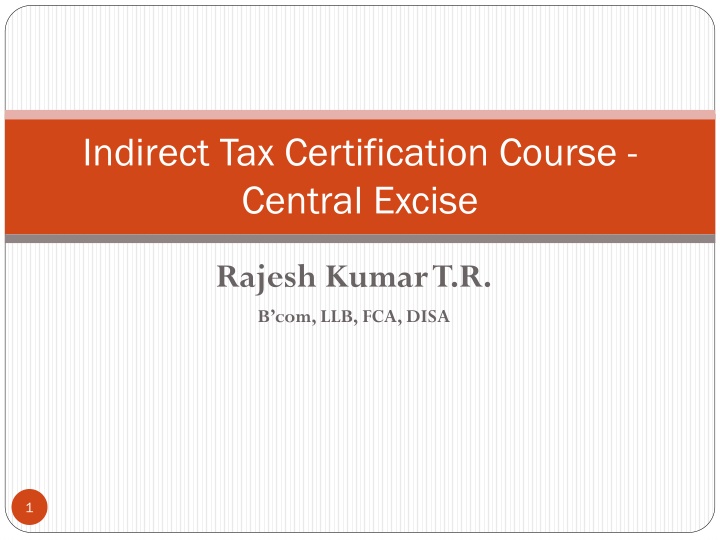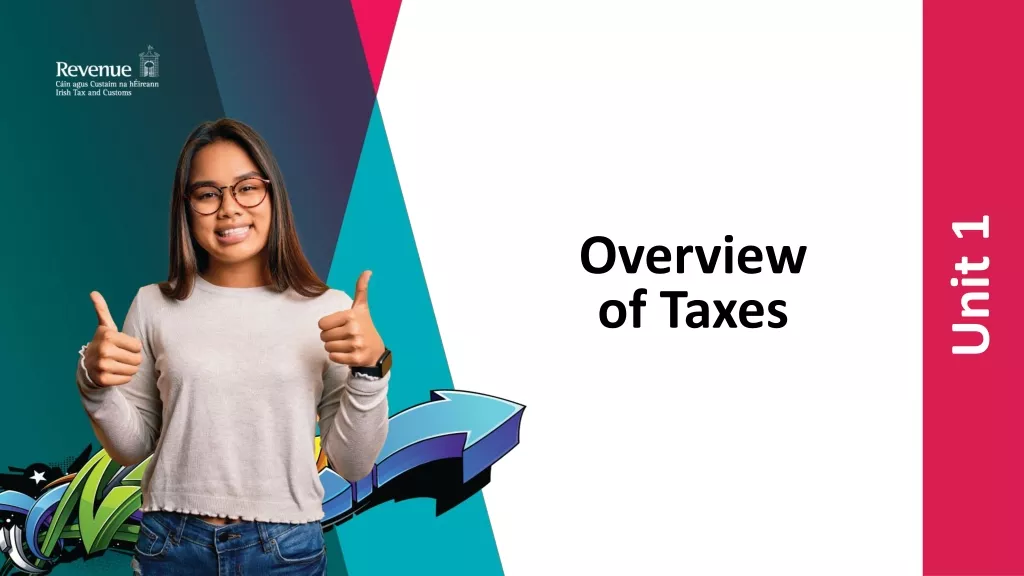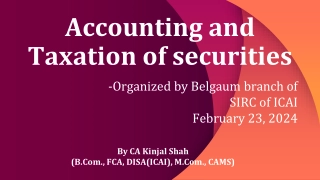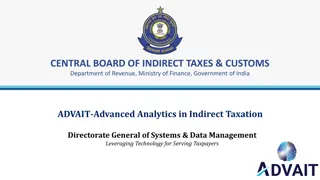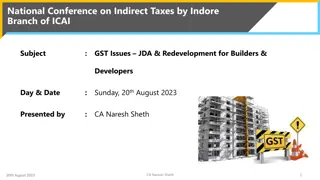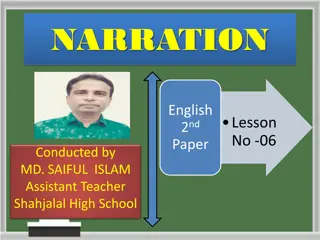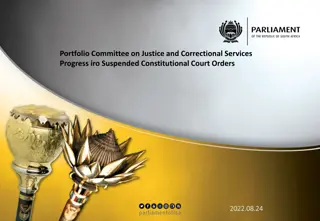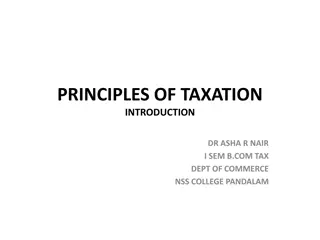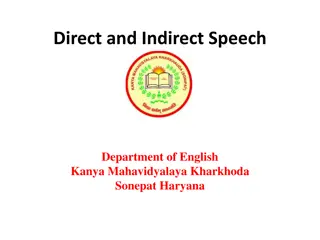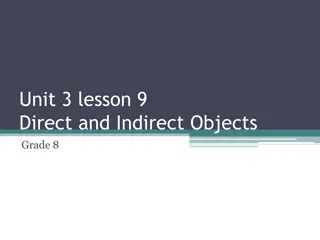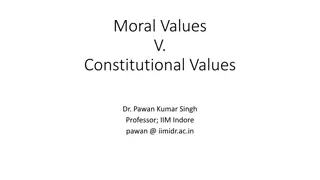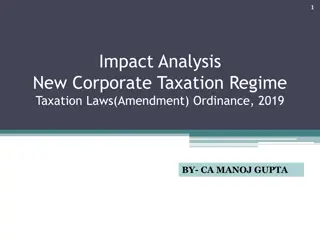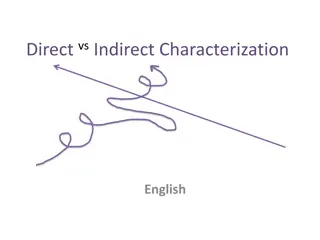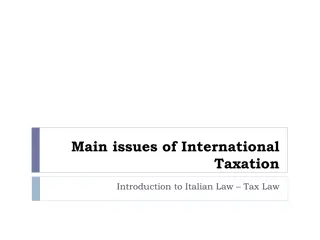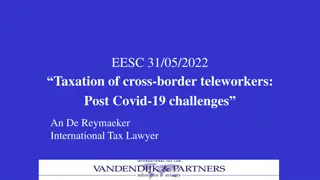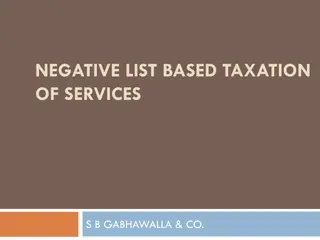Indirect Taxation in India: Insights and Constitutional Aspects
Delve into the world of indirect taxation in India through an exploration of revenue streams, budget estimates, tax structures, and constitutional aspects. Discover how Parliament and State Legislatures have exclusive powers to make tax laws, in accordance with Article 265 of the Constitution of India. Gain insights into the complexities and nuances of tax systems, including Central Excise, Corporate Tax, Income Tax, and more.
Download Presentation

Please find below an Image/Link to download the presentation.
The content on the website is provided AS IS for your information and personal use only. It may not be sold, licensed, or shared on other websites without obtaining consent from the author.If you encounter any issues during the download, it is possible that the publisher has removed the file from their server.
You are allowed to download the files provided on this website for personal or commercial use, subject to the condition that they are used lawfully. All files are the property of their respective owners.
The content on the website is provided AS IS for your information and personal use only. It may not be sold, licensed, or shared on other websites without obtaining consent from the author.
E N D
Presentation Transcript
Indirect Tax Certification Course - Central Excise Rajesh Kumar T.R. B com, LLB, FCA, DISA 1
Budget Estimates 2011-12 Revised Estimates 2011-12 Shortfall/ Excess Nature of tax Corporate tax 3,59,990 3,27,680 -32,310 Income tax 1,72,026 1,71,879 -147 Wealth tax 635 1,092 457 Taxes of Union Territories 1,973 2,317 344 Customs 1,51,700 1,53,000 1,300 Union Excise Duties 1,64,116 1,50,696 -13,420 Service Tax 82,000 95,000 13,000 Total 9,32,440 9,01,664 -30,776 3
400,000 350,000 300,000 250,000 200,000 150,000 100,000 50,000 0 Taxes of Union Territories 2,311 Corporation tax Union Excise Duties Income tax Wealth tax Customs Service Tax 2012-13 373,227 195,786 1,244 186,694 194,350 124,000 INR Crore Other Tax Revenues INR Crore Indirect Tax Revenues Taxes of Union Territories/ Others 3,555 Customs 186,694 Income tax 195,786 Union Excise Duties 194,350 Corporate tax 373,227 Service Tax 124,000 Total direct & other duties 572,568 Total indirect tax revenue 505,044 4
Part XII Finance, Property, Contracts and Suits Article 265 of the Constitution of India - No tax shall be levied or collected without the authority of law 6
Part XI Relation Btwn Union States - 245 Parliament Make Laws Whole or any part of the Territory of India State Legislature Whole or any part of the State No law made by Parliament shall be deemed to be invalid on the ground that it would have extra-territorial operation 7
Article 246 Parliament has exclusive power to make laws of matters covered in List I (union List) of VII Schedule State Legislature has exclusive power to make laws of matters covered in List II (State List) Concurrent List Both have powers 8
Seventh Schedule Union List- List -I Entry 83. Duties of customs including export duties. Entry 84. Duties of excise on tobacco and other goods manufactured or produced in India except- (a) alcoholic liquors for human consumption; (b) opium, Indian hemp and other narcotic drugs and narcotics, but including medicinal and toilet preparations containing alcohol or any substance included in sub-paragraph (b) of this entry. Entry 92C Taxes on Services Entry 97 - Any other matter not enumerated in List II or List III including any tax not mentioned in either of those lists. State List- List - II Entry 51. Duties of excise on the following goods manufactured or produced in the State and countervailing duties at the same or lower rates on similar goods manufactured or produced elsewhere in India:- (a) alcoholic liquors for human consumption; (b) opium, Indian hemp and other narcotic drugs and narcotics, but not including medicinal and toilet preparations containing alcohol or any substance included in sub-paragraph (b) of this entry. Entry 54. Taxes on the sale or purchase of goods other than newspapers, subject to the provisions of entry 92A of List I. 9
Entry 84 of Union List Duties of excise on tobacco and other goods manufactured or produced in India except: alcoholic liquors for human consumption; opium, Indian hemp and other drugs and narcotics, but including medicinal and toilet preparations containing alcohol or any substance including in sub-paragraph (b) of this entry (eg. Medical syrups for cold/cough) 10
Entry 51 of state list Duties of excise on the following goods manufactured or produced in the State and countervailing duties at the same or lower rates on similar goods manufactured or produced elsewhere in India:- alcoholic liquors for human consumption opium, Indian hemp and other narcotic drugs and narcotics but not including medicinal and toilet preparations containing alcohol or any substance included in sub- paragraph (b) of this entry 11
Entry 97 of Union List any other matter not included in List II, III and any tax not mentioned in list II or III This is residuary powers within the hands of Union. Challenge of levy of any new Central tax, has to pass the test of proving that it is beyond this residuary powers irrespective of what the tax is named/characterised as. 12
Basic Elements of Taxation Levy Will define the event upon which the duty/tax gets attracted Assessment Quantification of the levy attracted Collection The mechanism by which the Governments would collect the assessed tax 13
Levy and collection Levy collection meaning Somaiya Organics Ltd Vs State of UP, 2001 (130) ELT 3 (SC) the word collection in Art.265 would mean physical realization of tax, which is levied or imposed. Levy and collect are not synonymous terms. Levy means assessment or charging or imposition of tax, collect means physical realization. 14
Tax Art.366(28) of Const. of India Taxation includes the imposition of any tax or impost, whether general or local or special, and tax shall be construed accordingly. 15
What is Direct Tax The Central Board of Revenue Act, 1963 defines directtax to mean any duty leviable or tax chargeable under Estate Duty Act, 1953, Wealth-tax Act, 1957, Expenditure Tax Act, 1957, Gift Tax Act, 1958, Income-tax Act, 1961, Super Profits Tax Act, 1963, Interest Tax Act, 1974, Hotel Receipts Tax Act, 1980, and any other duty or tax which, having regard to its nature or incidence, may be declared by the Central Government, by notification in the official gazette to be a direct tax. 16
Courts views Eri Beach Company Ltd Vs Attorney General of Ontario, AIR 1930 PC 10 direct tax is one which is demanded from the very person who it is intended or desired should pay it. Indirect taxes are those which are demanded from one person in the expectation and intention that he shall indemnify himself at the expense of another. 17
Sources of CE law Central Excise Act, 1944 Rules CE Rules, 2002, Cenvat Credit Rules, 2004, CE (Appeal) Rules, 2001, CE (Advance Rulings) Rules, 2002, CE (Settlement of cases) Rules, 2007, CE (Removal of Goods at Concessional Rate of duty for manufacture of excisable goods) Rules, 2001, 19
Sources of CE law CE Valuation (Determination of Price of Excisable Goods) Rules, 2000, CE (Compounding of Offences) Rules, 2005, CE (Determination of Retails Sale Price of Excisable Goods) Rules 2008 Central Excise Tariff Act, 1985 Notifications Case laws and Circulars 20
Charging/Levy Section - 3 There shall be levied and collected in such manner as may be prescribed a duty of excise to be called the Central Value Added Tax (CENVAT) on all excisable goods (excluding goods produced or manufactured in special economic zones)] which are produced or manufactured in India as, and at the rates, set forth in the First Schedule and Second Schedule to the Central Excise Tariff Act, 1985 21
Elements of Levy Production/Manufacture In India Of Goods Excisable (Set out in 1st & 2nd Sch. To CETA subjected to duty) 22
Sec. 3 Other Aspects Goods Manufactured in EOU and brought to other place in India Duties of Excise to be paid Amount equal to the aggregate of the duties of customs which would be leviable on like goods produced or manufactured outside India if imported into India. Valuation would be based on Customs Goods Manufactured by or on behalf of Government would be same like any other Mfr. Power to fix Tariff values to C.G. 23
Manufacture Definition 2(f) Manufacture includes any process, - i) incidental or ancillary to the completion of a manufactured product; AND ii) which is specified in relation to any goods in the Section or Chapter notes of the First Schedule to the Central Excise Tariff Act, 1985 (5 of 1986) as amounting to manufacture; OR 24
Manufacture Definition 2(f) iii) which, in relation to the goods specified in the Third Schedule, involves packing or repacking of such goods in a unit container or labelling or re-labelling of containers including the declaration or alteration of retail sale price on it or adoption of any other treatment on the goods to render the product marketable to the consumer and the word manufacturer shall be construed accordingly and shall include not only a person who employs hired labour in the production or manufacture of excisable goods, but also any person who engages in their production or manufacture on his own account; 25
Manufacture - analysis Definition starts with the word includes 3 limbs in the definition 2nd and 3rd limb Deemed manufacture 26
Manufacture UOI Vs Delhi Cloth & General Mills Co.ltd, 1977 (1) ELT J.199 (SC) manufacture implies a change, but every change is not manufacture and yet change of an article is the result of treatment, labour and manipulation. But something is necessary and there must be transformation; a new and different article must emerge having a distinctive name and character or use. Also see South Bihar Sugar Mills ltd Vs UOI, 1978 (2) ELT J.336 (SC). 27
Manufacture Empire Industries ltd Vs UOI, 1985 (20) ELT 1 (SC) to constitute manufacture it is not necessary that one should absolutely make out a new thing because it is well settled that one cannot absolutely make a thing by hand in the sense that nobody can create matter by hand (scientifically). It is transformation of matter into something else that would amount to manufacture. That something is a question of degree. 28
Manufacture What comes out after processing is a different commercial commodity having its distinct character, use and name and is commercially known as such, is an important consideration in determining whether there is a manufacture. 29
Manufacture UOI Vs Parle Products, 1994 (74) ELT 492 (SC) - Whether or not something results in manufacture would depend on the facts of the case but any number of processes undertaken which do not result in a commercially different commodity cannot result in manufacture. 30
Manufacture Ujagar Prints Vs UOI, 1988 (38) ELT 535 (SC) Prevalent and generally accepted test to ascertain whether there was manufacture was whether the change or the series of changes brought by application of processes take the commodity to the point where, commodity can no longer be regarded as the original commodity but is, instead, recognised as a distinct and new article that has emerged because of the result of the processes. 31
Manufacture There might be borderline cases where either conclusion can be reached with equal justification. Insistence on any sharp or intrinsic distinction between processing and manufacture results in an over simplification of both and tends to blur their interdependence in cases. 32
Manufacture - processes Manufacture involves a series of processes. A process is one of the activities undertaken for manufacture of a product from input materials. 33
Process amounting to Manufacture Conversion of jumbo rolls of photographic films into small flats and rolls in the desired sizes Indian Cine Agencies Vs CIT Purification and filtration done to product hydrochloric acid and sulphuric acid marketable in the international market CCEx Vs Alok Enterprises 34
Processes not amounting to Manufacture Process of slitting and cutting of steel sheets and polyester films, which are used for lamination, as the resultant product was not having different character, name and use. Pickling and oiling of metals as preparatory steps does not amount to manufacture Circular 927/17/2010 deemed in 2012 Process of cleaning used mobil oil doesn t amount to manufacture as no new commercial commodity comes into existance. 35
Manufacture vs production Dictionary meaning of produce to bring forward, to bring forth or out, to bring (to a specified condition), to bring into existence or being, to work up from raw material, manufacture (material) objects. Hyderabad Asbestos Ltd Vs UOI, 1980 ELT 735 manufactured and produced were synonymous same test should be applied. Produced used in respect of natural items. 36
Deemed manufacture Processes which may not amount to manufacture in their natural meaning Brought under tax ambit by the artificial definition Processes mentioned in CETA as manufacture Third schedule in CETA repacking, re-labelling, putting or altering retail sale price etc. mostly consumer goods. 37
Deemed Manufacture 2(f)(ii) Processes which are specified in relation to any goods in the Section Notes or Chapter Notes to the First Schedule to CETA; Mere specification of a process in the Tairff entry not sufficient; Should be specifically stated that the process amounts to manufacture. 38
Deemed Manufacture 2(f)(ii) Example Chapter / Section Notes for Processes amounting to Deemed Manufacture Ores, Slag and Ash Process of converting ores into concentrate Marble, Granite, sandstone, etc Process of cutting or sawing or sizing or polishing of blocks or any other process of converting stone blocks into slabs or tiles Aluminium Tubes & Pipe The process of drawing or redrawing Iron and Steel Process of drawing or redrawing a bar, rod, wire rod, round bar or any other similar article into bright bar. Process of galvanization Beverage, Spirit and Vinegar Labelling or relabelling of containers, or, packing or repacking from bulk packs to retail packs, or, adoption of any other treatment to render the product marketable to the consumer 39
Deemed Manufacture 2(f)(ii) Example Chapter / Section Notes for Processes amounting to Deemed Manufacture Misc edible preparations Labelling or re-labelling of containers or re-packing from bulk packs to retail packs of pan masala, yeast, sauces, extracts from tea/coffee shall amount to manufacture Affixing brand name, labelling or re-labelling or repacking from bulk pack to small pack of readymade garments (Articles of Apparel) is manufacture Made up textile articles; sets; worn clothing & worn textile articles; rags Natural or coloured pearl; precious or semi precious stones; precious metals; Imitation jewellery; Coin Sound recorders and reproducers Process of refining dore bar Recording of sound or other phenomena on audio or video tapes shall amount to manufacture 40
Deemed manufacture 2(f)(iii) Goods specified in Third Schedule to CETA Packing or repacking in a unit container Labelling or re-labelling of containers including the declaration or alteration of retail sale price on the container or Adoption of any other treatment on the goods to render the product marketable to consumer. 41
Deemed manufacture 2(f)(iii) Air Liquide North India Pvt. Ltd. Vs CCEx. [2011] 271 ELT 321 (SC) Relabeling and repacking of gas in small cylinders Helium gas rendered marketable to ultimate consumers thereof Amounts to manufacture 42
Manufacturer Person who carries on the activity of manufacture. Job worker Brand owner not manufacturer Cibatul Ltd Vs UOI, 1978 (22) ELT 302 (SC) principal to principal basis. Should not be dummy. 43
Goods Art.366(12) Goods include all materials, commodities and articles. Sale of Goods Act, 1930 section 2(7) Goods every kind of moveable property other than actionable claims and money; and includes stocks and shares, growing crops, grass and things attached to and forming part of the land which are agreed to be severed before sale or under the contract of sale. 44
Goods UOI Vs Delhi Cloth Mills, 1997 (1) ELT J.199 (SC), - in order to be goods, the articles must be capable of coming to the market to be bought and sold. Therefore the items must be moveable and marketable. 45
Goods Moveability: DCM case South Bihar Sugar Mills Vs UOI, 1978 ELT J.336 (SC) The articles must be something, which can ordinarily come or can be bought to the market to be bought and sold. As opposed to moveable goods, immoveable property cannot be brought to the market to be sold. 46
Goods Section 3(36) GC Act, 1897 moveable goods mean property of every description except immovable property Section 3(26) GC Act, 1897 immoveable property shall include land, benefits to arise out of land, and things attached to the earth or permanently fastened to anything attached to the earth. 47
Goods Marketability: Capability of a product of being put into the market for sale. Union Carbide India ltd Vs UOI, 1986 (24) ELT 169 (SC) An article must be something which can ordinarily come to the market to be bought and sold. Articles in crude or elementary form are not dutiable as they are merely intermediary products and not goods. Aluminum cans or torch bodies produced by extrusion process neither sold nor marketable not goods. 48
Goods CCE Vs Ambalal Sarabhai Enterprises, 1989 (43) ELT 214 (SC) Duty of excise is on the manufacture of goods and for an article to be goods, it must be known in the market as such or must be capable of being sold in the market as goods. Actual sale is not necessary. Usage in captive consumption is not determinative of whether the article is capable of being sold in the market or is known in the market as goods. 49
Goods Even transient items/articles can be goods, provided they are known in the market as distinct and separate articles, having separate uses. Thus, goods with unstable character can be theoretically marketable if there was a market for such transient types of articles, but one has to be take a practical view on the basis of available evidence. 50
